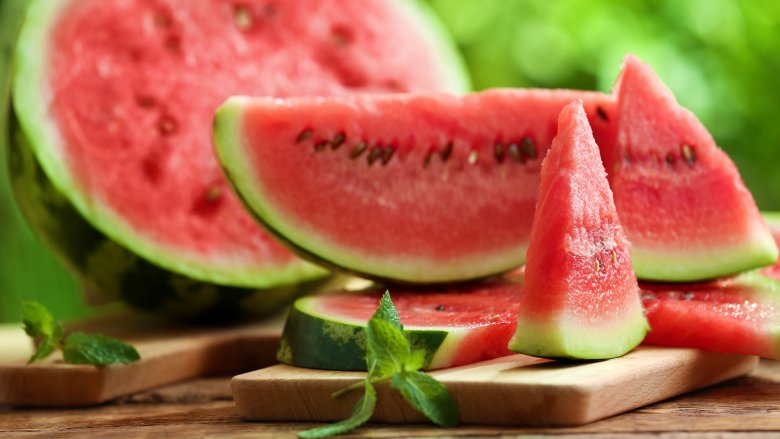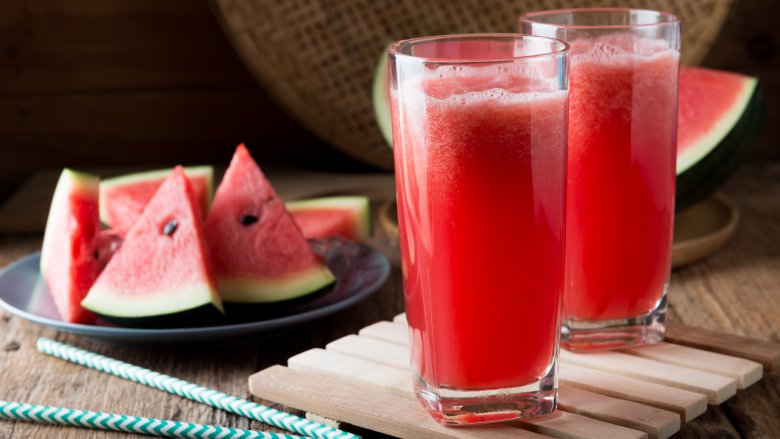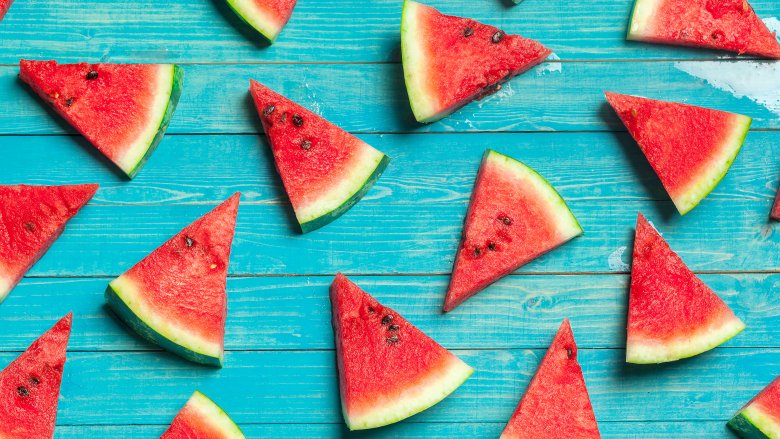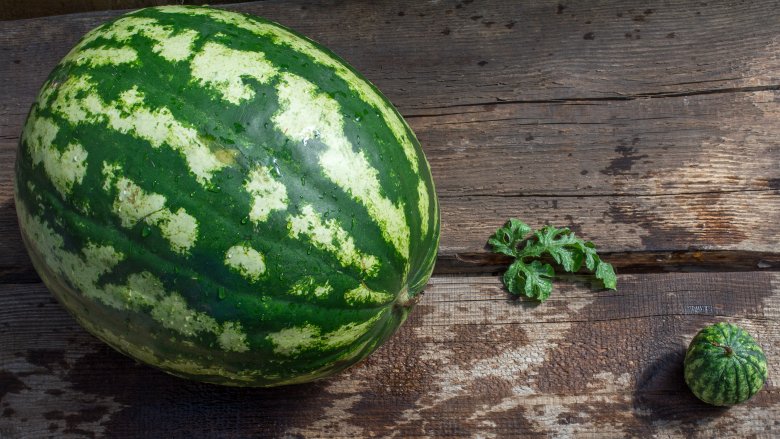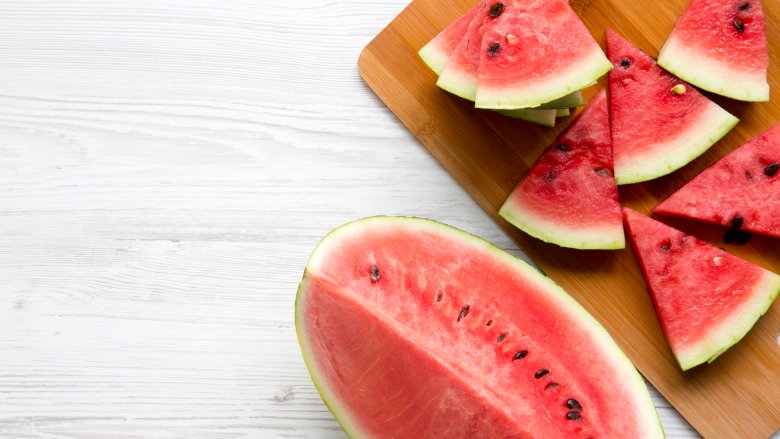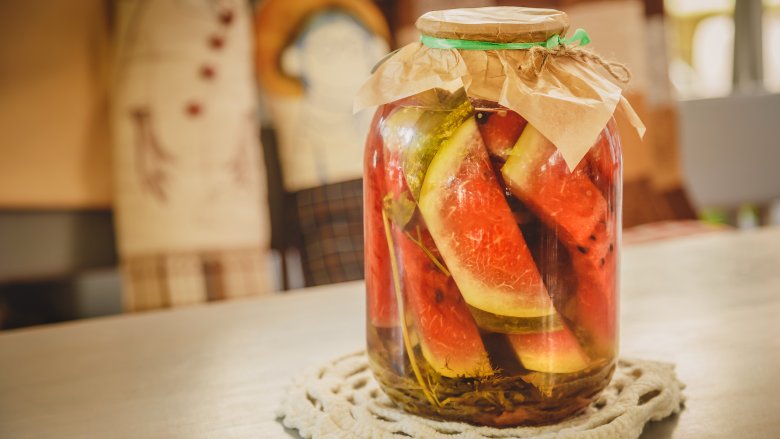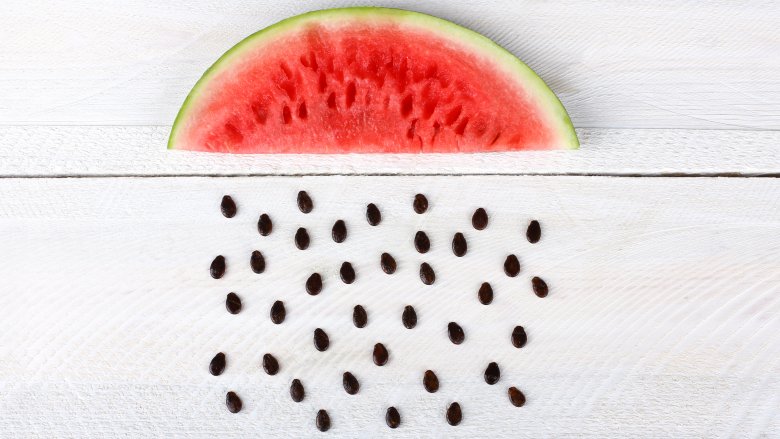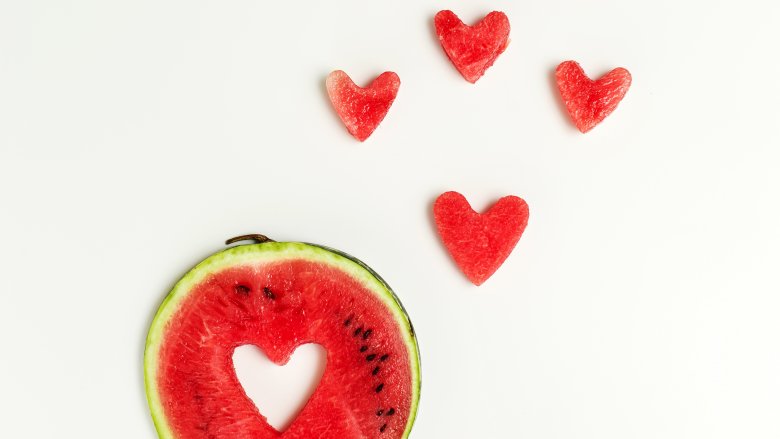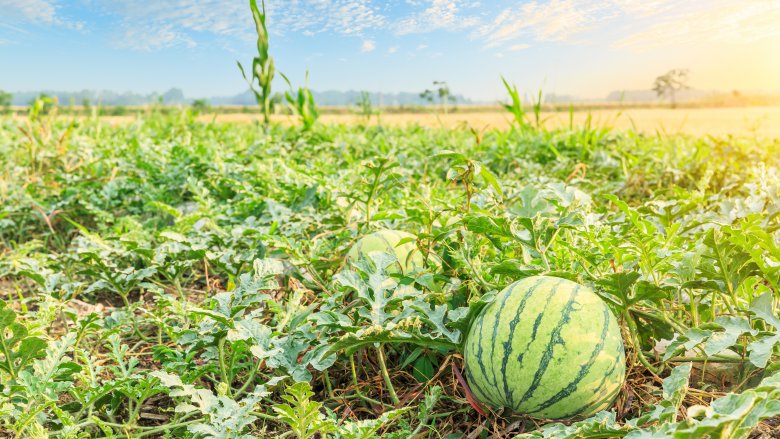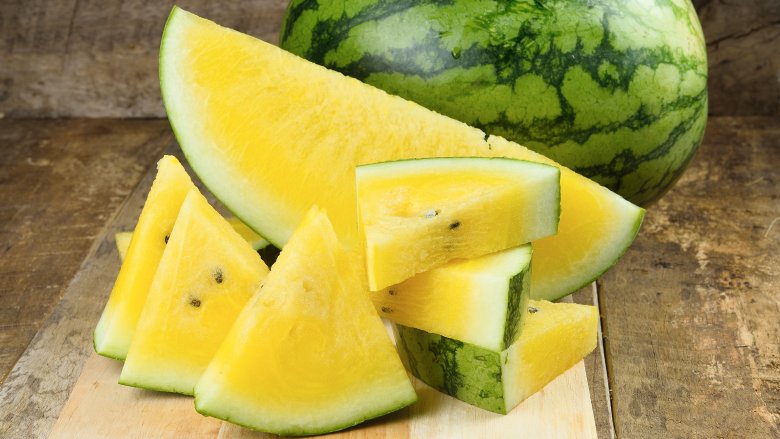What You Need To Know Before You Take Another Bite Of Watermelon
We're pretty hard pressed to find anything bad to say about watermelon. I mean, how can you hate on something that tastes like a dessert but hydrates your body like a sports drink, all without setting off a calorie bomb in your belly? In addition to chowing down on a refreshing wedge at a backyard barbecue, there seem to be innumerable ways to use a watermelon: You can make adorable little melon balls or grill a few wedges to serve as an appetizer. Blend it into your morning smoothie or churn it into ice cream. Toss it with salty feta and call it a salad, or get creative and turn the whole honking thing into a boozy keg. There are some pretty amazing ways to use up watermelon, so don't be afraid to get creative if you find yourself with leftovers. Because, let's be real — the average watermelon yields 14 to 18 pounds of edible fruit, and who can eat that much in one sitting?
Because it's so delicious and versatile, we have to wonder if watermelon could possibly taste delicious and be good for you. After all, some fruits should really be on a no-fly list because of their high sugar content. Is watermelon one of them? Let's take a look at what you need to know before you eat another watermelon.
It hydrates and soothes sore muscles
One of our favorite things about watermelon is its high water content — 92 percent water to be precise. It's a great alternative to plain water, and unlike many citrusy sports drinks, watermelon is not very acidic. Drinking the juice isn't likely to cause acid reflux or other stomach irritating reactions. It also contains B vitamins to boost your energy levels and electrolytes (including potassium) to replenish nutrients lost as you sweat. Talk about a tasty way to prevent heat stroke this summer!
Watermelon also contains a rare type of amino acid known as citrulline, which works wonders on sore muscles. Studies have shown that athletes who drink watermelon juice before intense workouts have quicker recovery heart rates and fewer sore muscles the next day. Drinking watermelon juice may also increase overall athletic performance. When your body process citrulline, it turns into another amino acid called arginine. While arginine has many functions, it primarily rids the body of excess ammonia. Since exercising releases ammonia into the bloodstream, having higher levels of this amino acid can significantly reduce muscle fatigue and exhaustion.
It is possible to eat too much watermelon
In general, watermelon is pretty good for our bodies. It's low in calories and fat, chock-full of vitamins and minerals, and its high water content makes it incredibly refreshing, especially on a hot day. So, we were surprised to learn it is possible to overdo it with watermelon. This fruit is one of the best sources of a phytonutrient known as lycopene, the antioxidant responsible for giving the flesh its characteristic red color. Consuming antioxidants may prevent certain types of cancer and promote heart health, but load up on too much lycopene and you may find yourself with gastrointestinal distress. More than 30 mg a day can cause nausea, diarrhea, bloating, and indigestion. Luckily, you can eat as many as four cups of watermelon before you reach this point.
Anyone with hyperkalemia (too much potassium in the blood) might also want to limit their daily watermelon consumption. Each cup of watermelon contains 173 grams of potassium. For most of us, that's only five percent of the daily recommended intake, but it's enough to cause a potassium build-up in your blood if you don't process this mineral correctly. That can lead to chest pains, irregular heartbeat, and difficulty breathing.
Unripe watermelon doesn't have as many nutrients
Ripe watermelons not only taste sweeter, but they're actually more nutrient-dense, too! The Journal of Food Composition and Analysis tested watermelons of four different ripe stages: white, white-pink, pink, and red-ripe. They found the unripe fruit had almost no beta carotene and fewer nutrients overall while the riper fruits had higher levels of antioxidants and vitamin C.
So, how do you make sure to take home a ripe watermelon? It's difficult to tell with these hard-shelled fruits, but there are a few tricks to selecting a good one. When you pick it up, it should feel heavier than you'd expect. You should also give it a light knocking to make sure it returns a hollow sound. A dull thud means it's either over- or under-ripe. Finally, if you turn it around in your hands, you'll find the spot where the melon rests on the ground. If it's a pale yellow color, you're good to go. Any other color, and you may want to choose another melon.
You can go on a watermelon detox, but it's definitely a fad diet
We thought the cabbage soup diet was the weirdest one out there, but the watermelon detox absolutely takes the cake! The plan is designed to flush toxins out of your body by eating nothing but watermelon for breakfast, lunch, and dinner. Want a snack? Watermelon. Dessert? Yup, you guessed it: watermelon. Continue for five days (maybe with some other foods added back in after day three) and watch the pounds drop off. Considering that each wedge of watermelon has only 86 calories, you'd need to eat a whole watermelon or more each day to reach a safe caloric intake of 1,200 calories for women (or, 1,500 calories for men). We don't know about you, but we're not sure we could eat more than one each day!
If you make it through the week without going watermelon crazy, chances are good you'll gain back the weight once you go back to regular food. According to MedlinePlus, fad diets rarely result in lasting weight loss. And while watermelon has many vitamins and a small amount of protein and dietary fiber, you'd certainly be missing out on balanced nutrition during your detox week. Long term, it's best to add watermelon to part of your already healthy diet instead of relying on it as a magical weight-loss solution.
The rind is kind of good for you
Most of us eat the red flesh and throw out the rest, but it turns out the whole watermelon is good for you! Live Science reports that all parts of the watermelon can be eaten, including the rind. The white flesh near the rind actually contains more citrulline, a non-essential amino acid that's gaining popularity in health and wellness circles. This particular nutrient promotes blood flow and improves heart health.
Just because you can eat the rind doesn't mean you should chow down right away! Consuming the rind requires a bit of prepwork. Because it's tougher than the rest of the melon, most recipes call for removing the green peel first. Once peeled, use the rinds instead of cucumber in refreshing watermelon gazpacho recipes, or grate them and toss the shredded pieces into your favorite coleslaw recipes. They can also be softened up to make watermelon rind pickles or turned into candy.
You won't grow watermelons in your belly if you eat the seeds
When you were a child, you likely heard the old wives tale that huge fruits would grow in your belly if you accidentally ate any watermelon seeds. Not only is that untrue, but the seeds are 100 percent edible. The International Journal of Nutrition and Food Sciences has found many health benefits to consuming watermelon seeds. They contain fiber and protein, along with a significant amount of antioxidants, high levels of vitamin B, and several minerals (including magnesium, zinc, and potassium).
What's the catch? They can't be eaten straight away. Their nutrient quality increases if they're sprouted and shelled first. If you're not sure how to do that, Vertical Veg shares how to get started. Just let them soak in room temperature water for 12 hours before draining the water from the jar. Then, rinse them every 12 hours for three to four days until the sprouts emerge. Add the sprouted seeds to your breakfast granola, as a topping for your favorite grain bowl or soup, or eat 'em as a snack. Of course, you could always skip the labor-intensive sprouting process and roast them instead for a quick, almost-as-nutritious snack.
Eating watermelon may increase your libido
AgriLife Today jokes that while watermelon is popular on the Fourth of July, it may be better suited for Valentine's Day. Apparently, the fruit acts similar to Viagra. Eating watermelon delivers a boost of citrulline to your bloodstream, relaxing blood vessels much like an erectile dysfunction medication. Studies have also shown that consuming citrulline may increase your libido, too.
Unfortunately, watermelon isn't as organ-specific as Viagra, so it probably won't work as well as a doctor-prescribed medication. There doesn't seem to be a hard-and-fast rule for how much to eat to get these benefits, but LiveScience says it's probably a lot. Medical News Today brings up a good point about watermelon's high sugar content, too. It may be naturally occurring sugar, but consuming large quantities of watermelon can still raise blood sugar levels. Men with diabetes should discuss this treatment with their doctor before consuming watermelon for ED.
If you're counting your daily veggie intake, the watermelon counts
We would probably all agree that watermelon is a fruit...except for those who consider it a vegetable. Believe it or not, there's a lively debate about how to classify a watermelon. How did things get so complicated? Well, botanically speaking, watermelon is a fruit in the same way that a tomato is technically a fruit: The seeds develop in the ovary of the flowering plant instead of the roots or leaves.
Looking at watermelon from a scientific perspective, it's a member of the Cucurbitaceae family, plants that produce gourd vegetables like cucumbers and pumpkins. Like other vegetables, watermelons are planted from seed each year, harvested in one fell swoop, and the remaining vegetation is removed from the field so the process can be repeated next year. You see how things are getting tricky?
Join the debate if you like, or just go ahead and consider it whichever category you need for your food diary. Unless you live in Oklahoma, of course, where you'll have to concede it's a vegetable. Watermelon was declared the official state vegetable in 2007.
Don't be surprised if it's not red inside
There are hundreds of watermelon varieties, and not all of them have red flesh. Several types lack lycopene, the antioxidant that gives watermelon its red color. Instead, they're rich in beta-carotene, giving them a bright yellow hue or a slight orange tint. Unfortunately, it's nearly impossible to tell from the outside — almost all watermelons have striped green rinds.
When you're shopping at the grocery store, it's unlikely to pick up a yellow watermelon on accident. Most markets only offer one or two types of watermelon, all of which are red on purpose. If you can find varieties like Desert King, Tender-Gold, Yellow Baby, or Yellow Doll at a farmer's market, give one a try — yellow and orange watermelons are sweeter and more honeyed than the red varieties. Plus, they look pretty cool and they're a great way to impress company at a dinner party. If that's not an option and you have a green thumb, order some seeds and grow one of these varieties in your backyard.
